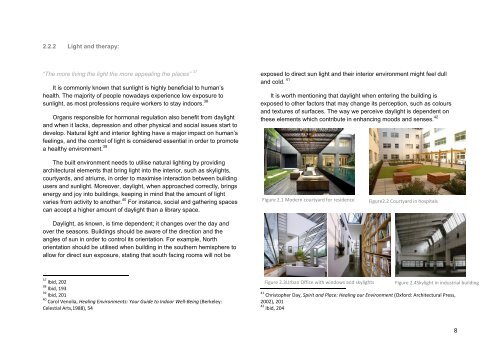Noor Abid_2016-02-19
Create successful ePaper yourself
Turn your PDF publications into a flip-book with our unique Google optimized e-Paper software.
2.2.2 Light and therapy:<br />
“The more living the light the more appealing the places” 37<br />
It is commonly known that sunlight is highly beneficial to human’s<br />
health. The majority of people nowadays experience low exposure to<br />
sunlight, as most professions require workers to stay indoors. 38<br />
Organs responsible for hormonal regulation also benefit from daylight<br />
and when it lacks, depression and other physical and social issues start to<br />
develop. Natural light and interior lighting have a major impact on human’s<br />
feelings, and the control of light is considered essential in order to promote<br />
a healthy environment. 39<br />
The built environment needs to utilise natural lighting by providing<br />
architectural elements that bring light into the interior, such as skylights,<br />
courtyards, and atriums, in order to maximise interaction between building<br />
users and sunlight. Moreover, daylight, when approached correctly, brings<br />
energy and joy into buildings, keeping in mind that the amount of light<br />
varies from activity to another. 40 For instance, social and gathering spaces<br />
can accept a higher amount of daylight than a library space.<br />
Daylight, as known, is time dependent; it changes over the day and<br />
over the seasons. Buildings should be aware of the direction and the<br />
angles of sun in order to control its orientation. For example, North<br />
orientation should be utilised when building in the southern hemisphere to<br />
allow for direct sun exposure, stating that south facing rooms will not be<br />
exposed to direct sun light and their interior environment might feel dull<br />
and cold. 41<br />
It is worth mentioning that daylight when entering the building is<br />
exposed to other factors that may change its perception, such as colours<br />
and textures of surfaces. The way we perceive daylight is dependent on<br />
these elements which contribute in enhancing moods and senses. 42<br />
Figure 2.1 Modern courtyard for residence Figure2.2 Courtyard in hospitals<br />
http://archinspire.org/modern-two-storeyresidence-courtyard-typology/<br />
http://www.artificialgrass.org.uk/news/sup<br />
er_verdegrass_at_broomfield_hospital/<br />
37 Ibid, 2<strong>02</strong><br />
38 Ibid, <strong>19</strong>3<br />
39 Ibid, 201<br />
40 Carol Venolia, Healing Environments: Your Guide to Indoor Well-Being (Berkeley:<br />
Celestial Arts,<strong>19</strong>88), 54<br />
Figure 2.3Urban Office with windows and skylights Figure 2.4Skylight in industrial building<br />
http://archinspire.org/modern-two-storey-residencecourtyard-typology/<br />
http://www.nps.gov/tps/tax-incentives/bef<br />
41 Christopher Day, Spirit and Place: Healing our Environment (Oxford: Architectural Press,<br />
20<strong>02</strong>), 201<br />
42 apply/qualified-expenses.htm<br />
Ibid, 204<br />
8



